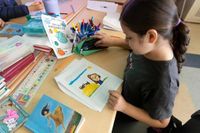The COVID-19 pandemic has left an indelible mark on the U.S. education system, affecting countless students and reshaping traditional learning methods. As schools across the nation shuttered in March 2020, educators swiftly transitioned to remote learning, an abrupt change that brought long-term challenges.
According to national data from the U.S. Department of Education, many students suffered significant academic setbacks during the pandemic, particularly in fundamental subjects like reading and math. Recent test scores from the National Center for Education Statistics reflect a sobering reality: students returned to classrooms with lower academic skills, struggling to regain what they lost. The Annie E. Casey Foundation notes, "The abrupt shift to remote learning challenged student and teacher engagement, dramatically decreased instructional time, and hindered student understanding." As a result, current estimates suggest that recovery from these setbacks could take a generation.
Michael Petrilli, president of the Thomas B. Fordham Institute, emphasizes the severity of this situation by stating, "Many of the kids affected by school closures during the height of the COVID-19 pandemic lost some of the most foundational skills in reading and math." Notably, many fourth graders navigating the current curriculum were kindergartners when school closures first began, thrust into an online learning environment that could not effectively replicate in-person instruction.
Despite the apparent challenges, supporters of the school closures argue that these were necessary for health and safety. Rep. Jahana Hayes, a former high school teacher, defended the closures against criticism, asserting, "We don’t need Brookings data to tell us that if kids are not in school, they won’t learn. That’s pretty basic... But we also know if kids are dead, they don’t learn.” This statement underscores the tension between safeguarding student well-being and upholding educational standards during an unprecedented health crisis.
Five years post-pandemic, educators note significant shifts in classroom dynamics. According to a national survey by EdWeek Research Center, over 70% of teachers report an increase in student misbehavior compared to pre-pandemic levels. The pandemic's impact on social skills has surfaced, with students missing foundational interactions. Teacher Wendy Gonzalez highlights this issue, noting many of her fourth graders lacked the skills to communicate effectively with their peers, a crucial asset they missed out on during formative years.
Meanwhile, the rise in chronic absenteeism has further complicated educational recovery efforts. An analysis from the American Enterprise Institute reveals that absenteeism rates have surged from 15% to 26% between 2018 and 2023, with nearly 30% of students classified as chronically absent by the 2021-22 school year. Lydia Rainey of the Center on Reinventing Public Education observes that many students now perceive school as optional, arguing that re-engaging them presents an ongoing struggle for educational institutions.
Moreover, reading proficiency remains a pressing concern. According to the National Assessment of Educational Progress (NAEP), reading scores have plummeted to their lowest levels in 30 years. Karyn Lewis, vice president of research at NWEA, states, "Students who missed foundational skills are still struggling with more advanced material. The recovery could take up to seven years in math alone,” demonstrating how deeply rooted the academic impact of the pandemic is.
Yet amidst these hurdles, technology has become a staple in modern classrooms. Reports indicate a dramatic increase in device accessibility, with approximately 90% of secondary and 80% of elementary students having personal devices compared to less than half pre-COVID. Many educators are now implementing artificial intelligence and innovative learning platforms, embracing digital tools to enhance student engagement.
Nevertheless, the education system is wrestling with teacher shortages, exacerbated by high turnover rates. After the 2020-2021 school year, about 8% of educators opted to leave the profession. This trend has disproportionately affected schools serving disadvantaged communities, resulting in a reliance on less experienced teachers and substitutes. Professor Lora Bartlett of the University of California, Santa Cruz highlights the role of increased political intervention during the pandemic, noting it often curtailed teachers' freedom in decision-making around curriculum and instruction, further diminishing job satisfaction.
As parents have reassessed their educational choices, the pandemic also fueled an increase in school choice initiatives. A recent survey from the National School Choice Awareness Foundation found that over half of parents were considering alternate schooling options in 2023. School choice advocates have utilized parent dissatisfaction to push for new legislation, increasing access to educational alternatives, including charter schools and micro schools.
Even though progress has been made in addressing these challenges, such as investments in tutoring and mental health support, sustaining these efforts remains vital as federal relief funds run dry. Schools are acknowledging the importance of individualized support for struggling students and have introduced social and emotional learning (SEL) curriculums to address mental health problems exacerbated by the pandemic.
In summary, while the COVID-19 pandemic brought about significant changes to the U.S. education landscape, the road to recovery is fraught with challenges. The long-lasting effects of the pandemic have prompted educators, policymakers, and parents to work collaboratively toward ensuring that all students receive the comprehensive support they need to succeed moving forward.





